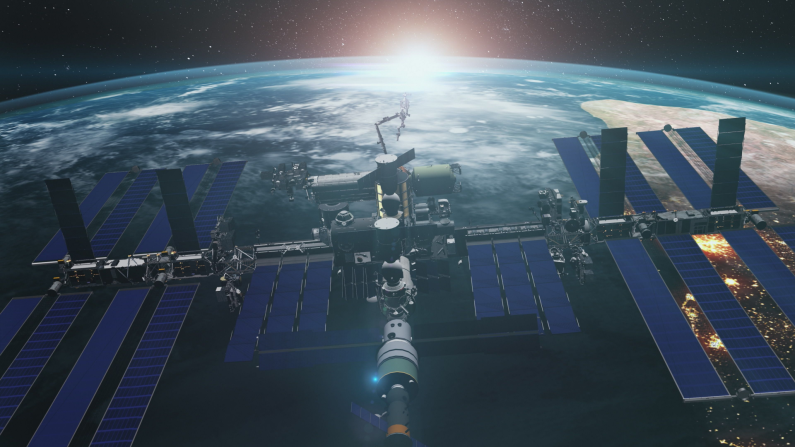Today, more and more commercial orbital complexes are emerging, even though many people still associate the space industry with massive, exclusively government-run projects. Yet private stations now combine laboratories, hotels, and testing grounds all in one. This is how a new sector is taking shape — the orbital economy.
The Retirement of the ISS and the Rise of Private Modules

By 2025, the fate of the International Space Station is virtually decided: it remains operational, but after more than two decades in orbit, global space agencies have been forced to acknowledge that its life cycle is nearing its end. The ISS will be deorbited and sunk in a non-navigable region of the Pacific Ocean within the next five years. Replacing it are private stations — compact, modular, and energy-efficient.
The key players in the new market include:
-
Axiom Space — the first private operator to attach its own module to the ISS and now building the fully autonomous Axiom Station.
-
Blue Origin and Sierra Space — creators of the Orbital Reef project, positioned as a “business park in low Earth orbit” with zones for research, manufacturing, and tourism.
-
Northrop Grumman — developer of an autonomous station based on technologies from the Cygnus cargo spacecraft.
-
Starlab by Voyager Space and Airbus — a station focused on scientific missions and industrial research.
These stations are typically located in low Earth orbit (≈400–500 km), inheriting the convenient “corridor” used by the ISS. But unlike a government-owned station, they operate under a different logic: each is a commercial platform offering access to multiple customers at once — from universities to private companies such as pharmaceutical firms, as well as space tourists.
Private stations conduct microgravity research, run manufacturing processes impossible on Earth, host tourist missions, test robotics and new technologies, and serve as “transfer hubs” for satellites and future lunar expeditions.
Space Manufacturing: Crystals, Nanomaterials, and Bioprinting

One of the core areas of commercial activity aboard private stations is advanced materials production and biomedical research. The reason lies in a unique environment unattainable under terrestrial conditions: microgravity.
On Earth, nearly all manufacturing processes are governed by gravity: fluids heat up and create convection currents, heavy particles settle, components separate by density, and materials form under the influence of their own weight. In space, these phenomena disappear — allowing access to fundamentally new material properties and entirely new modes of formation.
Which properties become accessible in microgravity:
- Perfect material uniformity. Without convection or sedimentation, particles distribute evenly. This enables the creation of ultra-pure crystals and defect-free optical fiber, which on Earth typically suffer from turbulence and gravity-driven impurity settling.
- Controlled crystallization. Crystals grow more slowly and more precisely: molecules settle into the lattice gradually, without distortions. Protein crystals formed in space become larger and more symmetrical — ideal for analysis, which accelerates drug discovery.
- Formation of alloys without stratification. On Earth, components in a molten mixture separate by density. In microgravity, this problem disappears, allowing completely mixed metallic alloys with new mechanical properties — strength, heat resistance, and plasticity.
- Creation of structures impossible on Earth. For example: tissue scaffolds, bioprinted organs, or 3D-printed soft biomaterials. On Earth, these structures collapse or deform under their own weight; in space, they maintain perfect geometry.
- Pure fluid dynamics. Liquid lenses, spherical droplets, ideal surfaces — in microgravity, fluids naturally form perfect shapes. This opens the door to new types of optical elements and experimental chemical reactors.
Sectors of Orbital Manufacturing
A key example is ultra-pure crystals and optical fiber. One of the most discussed products in recent years is ZBLAN fiber. In microgravity, it forms without microdefects and demonstrates light transmission superior to any fiber produced on Earth. Companies operating on private stations are creating the first batches used in telecommunications, medical optics, and laser systems.
Protein crystal production for pharmaceutical development is also expanding. Protein crystals grown in space have more accurate structures — meaning fewer defects, fewer impurities, and higher diffraction quality. This accelerates the development of drugs for cancer, autoimmune disorders, and viral infections. For example, Boehringer Ingelheim conducted research on biopharmaceutical molecules in orbit in collaboration with NASA and CASIS.
Another rapidly growing field is the bioprinting of human tissues — both on Earth and in space. Microgravity enables the printing of three-dimensional tissues without support structures, as they do not collapse under their own weight. Private stations are already testing scaffolds for future organs, studying bone regeneration, muscle growth, and stem cell behavior.
Nanomaterials and alloys are also manufactured in orbit. Certain metallic compounds develop smoother microstructures, while composite materials become stronger at lower mass. These developments are promising for aerospace, electric transport, and energy systems.
Orbit is simultaneously becoming a laboratory and a factory. Such production remains expensive for now, but as more stations appear and launch costs fall, large-scale expansion of the sector is expected.
Commercial Services: Tourism, Data Centers, and the Orbital Services Market

If a flight to the ISS once cost tens of millions of dollars, private stations now operate under a different model — rapid preparation of tourists and several days spent on a station with an entertainment program.
Such tourism remains expensive (a single trip still costs tens of millions of dollars), but it is no longer a rarity — more than ten private passengers now travel to orbit each year. For the stations, this is an important part of the business model: tourists help pay for the infrastructure, allowing companies to continue their research.
Orbital Data Centers
Another actively discussed direction is placing computing infrastructure in space.
Advantages include:
-
natural cooling,
-
robust protection from terrestrial cyber threats,
-
complete energy independence using solar panels,
-
minimal risk of physical intrusion.
Since anything related to space is inherently costly, companies are considering highly strategic applications: storing sensitive data, backing up critical computational systems, and placing AI-processing units in orbit.
Orbital Services
A new market for auxiliary space services is emerging. These include satellite refueling, the repair of orbital equipment, storage of rocket components, maintenance of telescopes, and cargo transport between stations. Orbit is turning into an ecosystem in which stations function as logistics and industrial hubs.
How This Changes the Launch Market

Private stations have dramatically reshaped launch economics over the past five years:
1. Launch frequency has increased
In the early 2020s, the global annual launch rate hovered around 120–130. By 2025, that number has more than doubled. The reason: a constant flow of cargo, crew, and equipment headed to commercial stations.
2. Rockets have become multi-format
New types of missions have emerged in which a single launch may include:
-
delivery of payloads to a station,
-
deployment of satellites,
-
transportation of equipment for scientific studies,
-
commercial passenger flights.
This increases overall economic efficiency.
3. Reusable rockets have become the dominant standard
Private stations reduce the cost of reaching orbit, intensifying competition among private launch providers. Reusability has become the norm, significantly reducing direct costs and making the space sector more financially accessible.
4. Capsules and mini-shuttles are rapidly developing
To support regular station operations, lightweight spacecraft capable of dozens of flights are being developed. These are the equivalents of a “new generation of shuttles” — compact, autonomous, and inexpensive.
For example, the Dream Chaser reusable shuttle is being developed by Sierra Space (formerly a division of Sierra Nevada Corporation).
Forecast: The Competitive Race for Low Earth Orbit

In the next five years, low Earth orbit will become the primary frontier of space competition. Several trends are already clear:
1. A multi-station orbital ecosystem
If in 2025 there are 3–4 major commercial stations being built, by 2030 the number could exceed ten. These will include:
-
highly specialized laboratory stations,
-
tourist hubs,
-
stations operated by corporate R&D centers,
-
orbital factories for serial manufacturing.
2. Transition from experimentation to industrialization
Today, only kilograms of materials are manufactured in orbit. Five years from now, production will be measured in tons: micro-alloys, biomaterials, pharmaceuticals, optical fiber. Space will become part of the global industrial supply chain.
3. Orbital logistics will emerge as an independent market
A wave of new companies will appear to:
-
deliver raw materials,
-
retrieve finished products,
-
service stations,
-
transport tourists,
-
maintain communication links between orbital facilities.
4. Governments will shift roles — from operators to customers
National space agencies will build fewer stations and instead rent modules and services from private companies.
5. Stations will become staging hubs for the lunar economy
Some private complexes will serve as transfer points for missions:
-
to the Moon,
-
to cislunar orbit,
-
to asteroids.
Low Earth orbit will serve as the logistical rear — a place for crew preparation, spacecraft refueling, and module assembly.
In this new reality, orbit is turning into an industrial cluster, a research megapolis, and a tourist destination all at once. Five years from now, the orbital economy will be as essential as today’s satellite communications market. And it may be private stations that become the “orbital cities” defining the future of space for decades to come.
Share this with your friends!





Be the first to comment
Please log in to comment